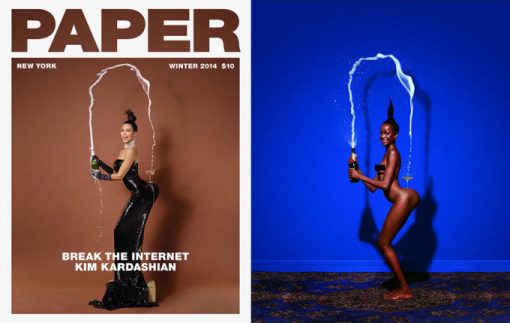 This week the queen bee of all the famous people who are famous for being famous people posed big booty-luscious for the cover of Paper Magazine. Kim Kardashian also gave full frontal, albeit with a blurred-gina, inside the November 12th issue. All Kim K’s super greasy exposed skin is worth absolutely none of your time, except for this:
This week the queen bee of all the famous people who are famous for being famous people posed big booty-luscious for the cover of Paper Magazine. Kim Kardashian also gave full frontal, albeit with a blurred-gina, inside the November 12th issue. All Kim K’s super greasy exposed skin is worth absolutely none of your time, except for this:
Of all the Kardashian roasting Kim’s pics have aroused, her brown-bodied progenitor has received precious little love (and attention, you know, is the new love). I don’t know where this sister is today, but I know she’s the original from back in the days. Her name is Carolina Beaumont. And because she existed, disrobed, popped a cork, and smiled for the camera decades before the E channel super-duper big money-maker clicked the red button on her very first camcorder, Ms. Beaumont deserves more than a meme on a FB stream.
Jean Paul Goode shot Ms. Beaumont’s photograph in 1976, and the image appears in his unfortunately titled 1982 coffee table book Jungle Fever. Grace Jones was Goode’s lover and artistic collaborator and was featured on the book’s cover. Grace Jones is fierce. I am not messing with Grace Jones. Even when she claws from a cage. Especially when she claws from a cage.
I am not messing with Carolina Beaumont either. I actually like the 76 shot of Ms. Beaumont in the context of that bacchanalian era. Given the sexual exploitation of the African woman across continents and through time, I like the picture even more. When I look at it, at her, I feel the free-wheeling unleashing of the Black woman’s body from centuries of rape by slave owners in this country and colonialists in most others – and from the subsequent silencing of Black female sexuality that we understandably and reflexively did to ourselves. In this post-Pop Art Era photograph, sex is fun. And fun is liberating.
I do note the phallic arc of the champagne, the obvious reference to the male, and I have sufficient side-eye for that. Did Goode fetishize brown bodies in his work? I think he was awed by them. Reverentially. This is a white boy turned on by sisters who are strong, and he isn’t afraid to center that strength as the most important element in each of these compositions. Indeed, Black women’s strength is the focal point of Goode’s work with girls like Grace. So, despite the androcentric froth landing on Sister Beaumont, she looks happy in this picture, and her happiness is freeing. The 1976 photograph is fine (and fun!) art. Sans the Crisco used on Kim, Beaumont shines.
What’s dull is the 2014 re-duh version. My quarrel is with more than the fact that Goode’s redundancy feels… redone. Kim K’s pic, done in the post(?)-90s-video-booty-wop era, feels particularly sinister. Sex is not fun in the Kim K shot. In 2014, in this week’s Paper, sex is staged, displayed, splayed. All to get paid.
More porn than fine art print, the monetization of Kim K’s Asian body is problematic for all women. Nothing liberates in the Kardashian image. Ever since AIDS poisoned Free Love and left us with Safe Sex, women’s bodies in the popular culture titillate, market, even mock. But they do not glow with innate and inner glory. Women’s bodies are no longer wonders – or wonderful. Appropriated, even incorporated, KK is more Baartman than Beaumont. I wish Kim were more… confident. Maybe then Kim would do more than pose 1976 photography – maybe, with a little less insecurity and obvious narcissistic need for attention, Kim could do something more substantive, something more like 1976 feminism.
Maybe.
Baartman – http://dianaferrus.blogspot.com/